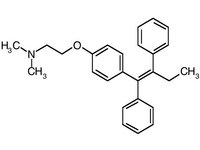The estrogen-receptor blocker tamoxifen has been shown to approximately halve the cancer recurrence rate when taken for five years after surgery for early-stage breast cancer. However, increased rates of adverse events occur if tamoxifen therapy continues beyond five years. Aromatase inhibitors, which block the synthesis of estrogen, have been used for treatment of metastatic breast cancer. Goss and colleagues present data on the use of an aromatase inhibitor, letrozole, for prevention of breast cancer recurrence in women who have completed five years of tamoxifen therapy.
This randomized, double-blind trial, conducted under the auspices of the National Cancer Institute of Canada Clinical Trials Group, enrolled 5,187 postmenopausal women with estrogen-receptor-positive breast cancer who had completed surgical treatment and five years of tamoxifen therapy. Women were randomized to receive either letrozole in a dosage of 2.5 mg once daily or placebo. The trial originally was designed to last approximately five years, but results were released early when interim analysis at a median follow-up of 2.4 years revealed a significant benefit with the use of letrozole. Ipsilateral recurrence of breast cancer or a new contralateral breast cancer occurred in 2.9 percent of women taking letrozole, compared with 5.1 percent of women receiving placebo, which was a statistically significant reduction. There was no significant difference between letrozole and placebo in the overall mortality rate (the estimated four-year survival rate for patients taking letrozole was 96 percent, versus 94 percent in patients taking placebo). The trial committee terminated the study after this interim analysis and offered letrozole to participants who had been randomized to placebo.
Women taking letrozole were more likely to have low-grade hot flushes, arthritis, arthralgia, and myalgia than women taking placebo. There was also a trend toward an increased rate of new osteoporosis diagnoses in patients taking letrozole.
The authors conclude that the use of letrozole after five years of tamoxifen therapy decreases the rates of ipsilateral breast cancer recurrence and new contralateral breast cancer by almost one half after a median of 2.4 years of treatment.
Goss PE, et al. A randomized trial of letrozole in postmenopausal women after five years of tamoxifen therapy for early-stage breast cancer. N Engl J Med November 6, 2003;349:1793-802.
EDITOR'S NOTE: An accompanying editorial (1) weighs the pros and cons of stopping this trial after an interim analysis, with only 2.4 years of follow-up. While more women were offered beneficial therapy at an earlier point, the short follow-up period prevented a more thorough analysis of unintended risks. The editorial authors note that tamoxifen initially was considered to be a relatively risk-free intervention for prevention of breast cancer recurrence, but follow-up revealed increased rates of adverse events after more than five years of use. The long-term decrease in circulating estrogen levels with prolonged use of letrozole theoretically could increase rates of osteoporosis and cardiovascular disease, which might mitigate the benefit from reduced rates of recurrent breast cancer. The lack of long-term data from this trial will complicate the decision for physicians and breast cancer patients of how long to recommend continuing letrozole therapy for prevention of breast cancer recurrence.--B.Z.
REFERENCE
(1.) Bryant J, Wolmark N. Letrozole after tamoxifen for breast cancer--what is the price of success? N Engl J Med 2003;349:1855-7.
COPYRIGHT 2004 American Academy of Family Physicians
COPYRIGHT 2004 Gale Group



